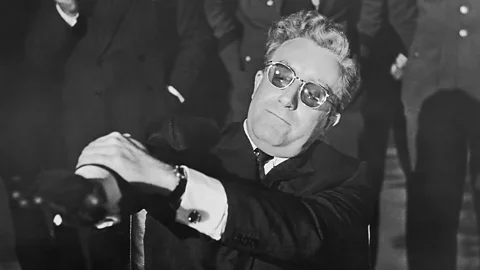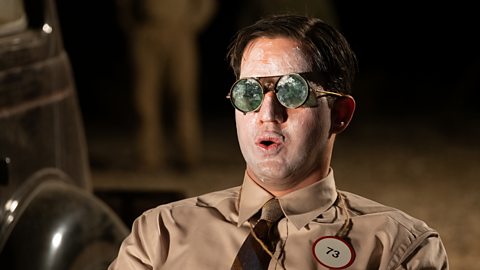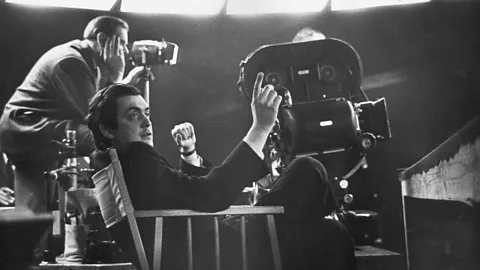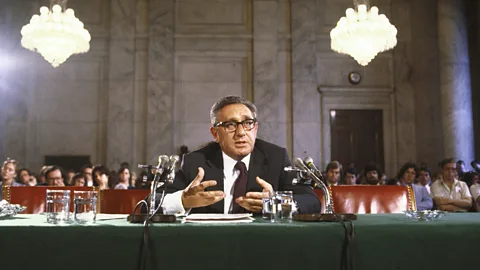By Dorian LynskeyFeatures correspondent

 Getty Images
Getty Images
As Stanley Kubrick’s satirical masterpiece Dr Strangelove turns 60, an ongoing mystery endures: who was the real-life inspiration for his demonic central character?
In 1999, a reporter from Scientific American asked the 91-year-old physicist Edward Teller whether it was true that he had been the real-life template for Dr Strangelove, the chilling scientific adviser played by Peter Sellers in Stanley Kubrick’s movie Dr Strangelove or: How I Learned to Stop Worrying and Love the Bomb.
Rumours had been circulating ever since the movie’s release on 29 January 1964. After all, Teller had worked with Robert Oppenheimer on the atomic bomb (he is played by Benny Safdie in Christopher Nolan’s film) and went on to spearhead the far more powerful hydrogen bomb. He had a terrifying reputation and a Hungarian accent as pronounced as Strangelove’s German one. When Teller made headlines again in the 1980s as the brains behind President Reagan’s so-called “Star Wars” defence initiative, several newspapers called him “the real Dr Strangelove”.
More like this:
– The one thing Oppenheimer gets wrong
But Teller exploded at the reporter. “My name is not Strangelove,” he snapped. “I don’t know about Strangelove. I’m not interested in Strangelove. What else can I say?… Look, say it three times more and I throw you out of this office.” Teller died in 2003, a year before the publication of Peter Goodchild’s biography Edward Teller: The Real Dr Strangelove, on the cover of which he is pictured wearing Sellers’ spectacles in a still from the movie. It is unlikely he would have appreciated it.

 Universal
Universal
It might seem strange that a fictional character was required to sell the story of one of the most consequential individuals of the 20th Century, but even now, on its 60th anniversary, Dr Strangelove is synonymous with the politics of nuclear war. Later this year, Armando Iannucci’s stage version will open in the West End, with Steve Coogan taking on Peter Sellers’ trio of roles.
Nothing is as unforgettable as the late-arriving Dr Strangelove himself: the sinister, amoral nuclear scientist
Kubrick’s masterstroke was to perceive grisly comedy and lethal irony where most people saw only horror. Prior to Dr Strangelove, the only significant movie about world-ending nuclear war was Stanley Kramer’s sombre, elegiac On the Beach, from 1959. Kubrick saw the value in making it funny. “If the modern world could be summed up in a single word it would be absurd,” he wrote in his notes. “The only truly creative response to this is the comic vision of life.” The film is packed with memorable scenes, lines and performances but nothing as unforgettable as the late-arriving Dr Strangelove himself: the sinister, amoral nuclear scientist who devolves into sieg heiling lunacy.
Goodchild’s biography is excellent but its subtitle owes more to marketing than accuracy, because Teller was not the only “real” Dr Strangelove. Other possibilities mooted over the years are the mathematician John von Neumann, the nuclear strategist Herman Kahn, the German rocket scientist Wernher von Braun and the foreign policy expert Henry Kissinger. Despite all the speculation, Kubrick never clarified the character’s origins. So did he base Strangelove on one of them, all of them, or none of them? Does the real Dr Strangelove even exist?
Kubrick’s ‘White House Rasputin’
One reason for the mystery is that Strangelove was not present in Kubrick’s source material. Writing as Peter Bryant, the Welsh former RAF officer Peter George published a novel in 1958 that was called Two Hours to Doom in the UK and Red Alert in the US. It was inspired by a recent media panic about the possibility that an accidental war could be set in motion by “a nervous, psychotic or fanatical launch officer”, as Carl Dreher put it in the Nation.
In Red Alert, a back-up plan to secure the US’s nuclear deterrent in the event of the president’s death results in a situation where one demented general can order a strike on the USSR that only he can call off. The novel tracks the desperate efforts of the American and Soviet governments to avert a full-scale nuclear exchange. It sold a quarter of a million copies in the US alone.

 Getty Images
Getty Images
Kubrick was already plotting a movie about nuclear war when, in 1961, a defence strategist in London gave him George’s novel with the disclaimer that such a dire chain of events was impossible. Kubrick didn’t care – the story confirmed his belief that the logic of nuclear deterrence was insane – so he optioned the novel, and asked George to collaborate on a screenplay. But Kubrick agonised over whether to make a straight adaptation, a more realistic drama or a satirical comedy. In spring 1962 he came up with a new character, a “White House Rasputin” called Dr Otto Strangelove, who became his gateway to a “nightmare comedy“. Kubrick hired the satirist Terry Southern to spice up the screenplay with jokes about sex and death.
The most compelling candidate for a real-life Strangelove is the only one who sounded nothing like him
The five potential models for Strangelove – Teller, von Neumann, Kissinger, von Braun and Kahn – had superficial similarities. They all worked in weapons development or Cold War strategy, and all but Kahn had thick European accents. Teller and von Neumann, two of the brilliant Hungarian refugees who worked on the Manhattan Project, both argued that the pursuit of knowledge was a scientist’s paramount duty, regardless of the consequences. “I do not want the hydrogen bomb because it would kill more people,” Teller once insisted. “I wanted the hydrogen bomb because it was new… I am afraid of ignorance.”

 Getty Images
Getty Images
Of the five, Kissinger is the least plausible inspiration. The future secretary of state was not a national figure in 1964, and was not linked to the character until the 1970s. Von Neumann, the genius – who made foundational contributions to computing, game theory, climate modelling and AI – used a wheelchair (like Strangelove) prior to his death from cancer in 1957 but he was a famously amiable character. Teller was more intimidating, and widely associated with the H-bomb, but nobody involved in the movie brought up his name. Peter Sellers explicitly cited von Braun (like Strangelove, a former Nazi) but he also claimed that he took the accent from Weegee, the celebrated Austrian-American photographer who documented the making of the movie, and the black glove from Rotwang in Fritz Lang’s 1927 sci-fi classic Metropolis, one of cinema’s first “mad scientists”.
The most likely prototype
The most compelling candidate for a real-life Strangelove is the only one who sounded nothing like him. Born in New Jersey in 1922, Herman Kahn was raised in the Bronx. His chewy New York accent, working-class origins and immense girth contributed to his becoming the US’s first celebrity nuclear strategist. Journalists compared him to the comedians Jackie Gleason and Zero Mostel, not just physically but temperamentally. “I can be really funny about nuclear war,” Kahn bragged.
Kahn became famous in 1960 with the publication of his bestselling book On Thermonuclear War. Kahn, who was wargaming potential conflicts for the US government’s RAND Corporation, believed that talking about nuclear war in terms of the end of humanity was dangerous, and that it was reckless not to consider a plan for victory and survival. In his mind, he was both a pragmatist and an optimist. But his book managed to offend hawks and doves alike, not to mention his own colleagues. Some readers found it psychopathic and obscene. One reviewer called it “a moral tract on mass murder: how to plan it, how to commit it, how to get away with it, how to justify it”.

 Getty Images
Getty Images
Because the scenarios imagined by the think-tank wargamers were a kind of speculative fiction, their research included novels. Kahn approvingly cited Red Alert in On Thermonuclear War. In George’s novel, the Soviets have developed an annihilating superweapon: a cluster of bombs, encased in cobalt, that could produce enough radiation to kill everyone on earth. Although the cobalt bomb never existed, it was an object of horrified fascination from the 1950s through to the early 70s, featuring in movies from On the Beach to Beneath the Planet of the Apes. Kahn argued that such a weapon would be a useless deterrent because nobody would ever use it, but he gave it a name that was too dramatic for its own good: the Doomsday Machine.
Kubrick borrowed Kahn’s coinage for the cobalt bomb in his movie. General Buck Turgidson (George C Scott) quotes the most hair-raising sections from Kahn’s book almost verbatim, Strangelove lifts from the chapter about underground shelters, and President Muffley (Sellers again) references Kahn’s most notorious line: “Will the survivors envy the dead?” The word “megadeath”, meaning one million deaths per nuclear explosion, was Kahn’s invention, too. Strangelove even works at the RAND-like “Bland Corporation” (not all the movie’s jokes are good). In one draft of the screenplay, Strangelove complains about the backlash to his Kahn-like book The Facts on Nuclear War. The numerous debts to On Thermonuclear War were not lost on Kahn, who suggested to an aghast Kubrick that he receive a percentage of the movie’s box office.

 Getty Images
Getty Images
It’s no surprise, then, that when the movie came out, both The Daily Mail and The Times claimed that Kahn was the prototype for Strangelove. But the Spectator dismissed the idea: “If Dr Strangelove is the type of the inhuman technician, utterly indifferent to the consequences of the exploitation of his discoveries, not only is Dr Kahn not the prototype of Dr Strangelove. He is almost the exact opposite of him. The difference, to put it succinctly, is that Dr Strangelove is mad and Dr Kahn is sane.” Certainly Kahn’s gregarious energy was nothing like Strangelove’s cold intensity. “How could my son be Dr Strangelove?” protested Kahn’s own father in 1968. “He is so warm and considerate.”
As it happens, Kahn was definitely the basis for the nuclear strategist Dr Groeteschele in Fail Safe, Sidney Lumet’s much more earnest 1964 film about a nuclear strike triggered by a computer error. But the media only cared about Strangelove. “Kubrick is a friend of mine,” Kahn told Newsweek. “He told me Dr Strangelove wasn’t supposed to be me.” Yet three years later he changed his story, claiming that the character was in fact a hybrid of Kissinger, von Braun and himself. Unlike Teller, he was far from offended by the gossip. It bolstered his celebrity and his income.
As for the other candidates, writes Peter Goodchild, the Strangelove connection was “a stigma… enhancing their links with the nuclear nightmare”. Despite his biography’s subtitle, Goodchild argues that Strangelove was “clearly a composite”, not a caricature of one individual. In fact, the hunt for the “real” Strangelove smudges Kubrick’s satirical point.
While researching the movie, Kubrick was shocked by how the experts’ professional pride “seemed to completely overcome any personal involvement in the possible destruction of their world”. Strangelove is the demonic personification of a way of thinking about war – highly intelligent yet bloodlessly abstracted from the reality of human suffering – that infected many scientists, strategists and politicians during the Cold War, and has not disappeared. He is not a man but an attitude, and attitudes are immortal.
Dorian Lynskey is the author of Everything Must Go: The Stories We Tell About the End of the World (April 2024).
If you liked this story, sign up for The Essential List newsletter – a handpicked selection of features, videos and can’t-miss news delivered to your inbox every Friday.
If you would like to comment on this story or anything else you have seen on BBC Culture, head over to our Facebook page or message us on Twitter.





